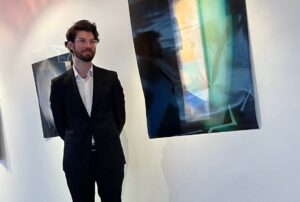On the third floor of the CEPA Gallery is an exhibition called “Bending Light.” Its creator Alex Cassetti took a little time to talk about it all, in about 20-minutes before we descended the stairs and walked back out of the gallery into traffic.
Cassetti is a grad school student at University at Buffalo, but there was another lifetime ago when he was living in Manhattan as a “black and white” photo guy. It was at that time that he took photos for magazines and generally had things altogether, working for a creative agency and a variety of magazines.
Then COVID-19 got its way across the borders and that was the end of that.
So now, Cassetti teaches classes and thinks of how an artist approaches photography. He said UB was a good fit for him.
“The reason I picked UB is the guy that runs the photography department, named John Opera – a guy I was then looking at for his work for quite a few years. He’s the only photographer in America that runs a department of photography where the center is in abstract-ism,” Cassetti said.
As a follower of this type of idea, and a photographer, Cassetti said that the field was always there, waiting to be discovered.
“It was discovered more than invented,” he said. “For me I don’t think about the invention of photography, but I do think photography has this level of abstraction and the visual itself is very abstract and I try to uncover that.”
Cassetti does this in many ways. With one work, he notes that he’s applied various images over one another, and then placed that over a transparent material. He also turned the two-dimensional into a three-dimensional object, by tearing at its center line and separating the two sides into planes of what can still be described as a photograph… but looks at what that is in a different way.
The lighting then further creates that “three-dimensional” look in what many people would consider a flat screen, or even a classic Polaroid invention gone wrong somewhere in the camera. Instead, the piece is fundamentally a sculpture, as Cassetti is a sculptor in 3D, but uses the tools of a photographer.
“When I made this image the heating system in my studio was waving and making this image kind of breathe. So I would look at this image for hours and making adjustments before it all comes together and feels right,” he said.
CEPA Gallery, as always, has provided the space and amenities needed to pull off what Cassetti intends to be – a very plain look at what photography is. While no heating system, he has placed his transparent films against a white wall with white nails to show what it looks like for a photographer to present his work to the public: a floating image on transparency film, a “plastic material with light sensitive chemicals on in,” that shows everything that is happening in his trained mind.
“This is the material I’m thinking about, what I’m seeing, what I’m archiving, what I’m shooting and also what I’m presenting the work as well. Also by presenting in this kind of way, the image almost floats,” he said.
Each piece in Cassetti’s show touches off the mind of the viewer in the space provided. He said that the image can change for whoever is looking at it as time goes by.
“What was happening at the opening was that people were viewing an image, but were trying to look at it from behind. They were backing away from it, but the work forces the viewer to be observational which is … as a photographer, we’re always observational. We’re always looking at things,” he said.
“I think this work beckons someone to look deeper. Look closer. What exactly are we looking at?”
Of his favorites, Cassetti pointed out a screenprint on transparency with white ink.
“On my idea on all this is make an invisible image. If I made an invisible image what would I do? It’s a white wall with a transparent film with white ink. Hung by white nails and white magnets,” he articulated. “It’s like an invisible thing, but what it actually turned out to be is if you look on the other side, you see the actual photographed image, on the other side … So, when I made this I was delighted. I really respond to this kind of minimalist approach and printmaking is a new thing to me, as well.”
Many of Cassetti’s images are, “a photograph, rephotographed, then photographed again and displayed.”
The images that are displayed at CEPA Gallery are from Cassetti’s own collection, mostly taken in upstate New York during the height of the pandemic. He couldn’t take pictures of people, as everyone was in lockdown, but he decided to make a conscious archive of his time there.
“Finding subject matter, photographing within my own selections and seeing what it can do,” he said.
“It turned out to be this relook at old work and turning it into a new image. When I was working for Vogue Italia I was working with archivists and photographing spreads of magazines and it was always amazing to me that you could photograph something that already exists, but you can make your own image in order for the new image to be in context. For me, it’s ‘How can I do that in my own work? How could I do that for myself?’ During the pandemic this was a way for me to look and think and photograph and reinvent my vision into something more contemporary.”
Cassetti’s show is on display until May 5.
CEPA Gallery | 617 Main Street, Buffalo, NY | (716) 856-2717
The post Seeing Light Bend with Alex Cassetti appeared first on Buffalo Rising.

